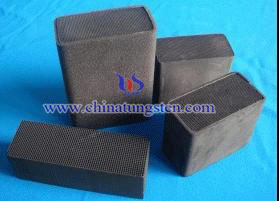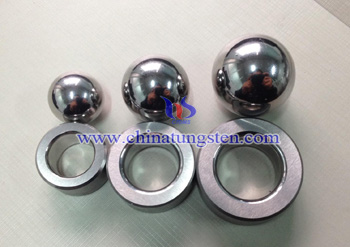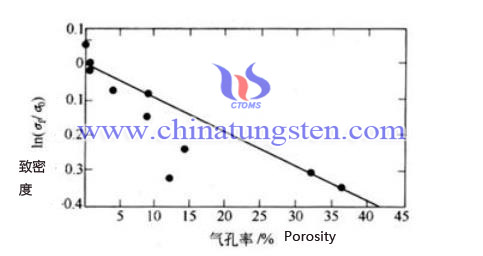Preparation of Low Cost SCR Method for Denitration Catalyst
- Details
- Category: Tungsten Information
- Published on Wednesday, 17 February 2016 18:40
- Written by chunyan
- Hits: 262
A low cost method to prepare SCR denitration catalyst which can reduce the preparation and operation cost, improve the abrasion resistant property of catalyst. The weight composes are like bellows: grounded slag powder takes 52~55%, gypsum 2.7~2.9%, partial ammonium metavanadate 1.3~1.5%, ammonium paratungstate 5.5~5.7%, silica sol 2.6~2.8%, clay 1.6~1.8%, glass fiber yarn 2.5~3.0%, methyl cellulose 2.7 to 2.9%, poly ethylene oxide 1.3~1.5%, a glycol ammonium 2.7~3.0%, distilled water of 20~23%.
The preparation steps are as follows:
1. Grinding and activate the carriers
Send grounded slag powder and gypsum by weight ratio of 17.9~20.4:1 into grinding equipment, inlet the high temperature steam (100 to 120℃), grinding and activate to get the carrier;
2. Preparation of slurry
Send carriers and ammonium metavanadate, ammonium paratungstate, silica sol, clay, glass, fiber, methyl cellulose, poly ethylene Huan and ethanol ammonium into the mixer, adding distilled water while stirring, stirring more than 2 hours until the solution uniform, to generate slurry with water below 25%;
3. Molding catalyst
Form the slurry in the required prepared shape, then dry and calcine to get the products we needed. The calcine conditions are like bellows: first calcined in 250~255℃ for 45~50 hours, then 370~390℃ calcined for 23~25 hours, again calcined at 445~455℃for 11~13 hours.
| APT Supplier: Chinatungsten Online ammonium-paratungstate.com | Tel.: 86 592 5129696; Fax: 86 592 5129797;Email:sales@chinatungsten.com |
| Tungsten News&Tungsten Prices, 3G Version: http://3g.chinatungsten.com | Molybdenum News & Molybdenum Price: http://news.molybdenum.com.cn |
Preparation for Ammonia Selective Catalytic Reduction of Honeycomb Denitration Catalyst
- Details
- Category: Tungsten Information
- Published on Wednesday, 17 February 2016 18:38
- Written by chunyan
- Hits: 247
 We propose a honeycomb ammonia selective catalytic reductive SCR catalyst preparation method with simple process, high strength, and denitrification activity, continued for a long time in this paper. The catalyst uses Ti02 as carrier, V205 as active component, W03 as co-catalyst. In which Ti02 anatase is used to be the raw materials of carrier, 80% content of the catalyst weight; V205 is added in the form of ammonium metavanadate, 0.1%-5% of the catalyst weight percent content; co-catalyst as W03 added in the form of ammonium paratungstate, 1%-20% of the catalyst weight percent content.
We propose a honeycomb ammonia selective catalytic reductive SCR catalyst preparation method with simple process, high strength, and denitrification activity, continued for a long time in this paper. The catalyst uses Ti02 as carrier, V205 as active component, W03 as co-catalyst. In which Ti02 anatase is used to be the raw materials of carrier, 80% content of the catalyst weight; V205 is added in the form of ammonium metavanadate, 0.1%-5% of the catalyst weight percent content; co-catalyst as W03 added in the form of ammonium paratungstate, 1%-20% of the catalyst weight percent content.
Steps are as follows:
1. Preparation of carrier stock
Take Ti02 powder, stirring in the water bath at the temperature of 60~80℃, get support slurry;
2. Join the loaded active component and other additives
Slowly add ammonium metavanadate and ammonium paratungstate into the carrier stock during the mixing process, and then add a variety of additives;
3. Mixing in the pug mill and being stale
Transfer the slurry obtained in step 2 to vacuum refining mud machine mixing, and stale in the constant humidity, continue to kneading. Pug kneaded for half an hour each time, the stale time is 8 hours, repeated several times to generate mud practiced;
4. Molding. Shaped the mud in the honeycomb;
5. Drying and roasting the catalyst
Dry the honeycomb for 3~6 days in drying box which the humidity and drying speed is controllable; and then roasted in the furnace of 300~600℃ for 12~24 hours, then to obtain the final honeycomb catalyst.
| APT Supplier: Chinatungsten Online ammonium-paratungstate.com | Tel.: 86 592 5129696; Fax: 86 592 5129797;Email:sales@chinatungsten.com |
| Tungsten News&Tungsten Prices, 3G Version: http://3g.chinatungsten.com | Molybdenum News & Molybdenum Price: http://news.molybdenum.com.cn |
Tungsten Carbide Valve Ball Applicability (1/2)
- Details
- Category: Tungsten Information
- Published on Wednesday, 17 February 2016 17:48
- Written by xiaobin
- Hits: 222
Application of carbide materials plus computer-aided design (CAD), computer aided manufacturing (CAM) and a flexible manufacturing system (FMS is controlled by a unified information system, material handling system and a set of digital control and processing equipment composition, can adapt to the introduction of automated machinery manufacturing system of the object transformed Flexible manufacturing system) and other related technology allows design and manufacturing efficiency and accuracy of the ball valve have been greatly improved.
Tungsten carbide ball valve without any abrasion and wear in the rapid process of opening and closing, and the flow resistance is small and close to zero infinitely when it fully opened, which can well endure the larger pressure difference fully closed. Therefore, equal diameter ball valve can be widely used in pipeline cleaning of oil and gas work. Most of tungsten carbide ball valve due to its ability to wipe a certain opening and closing process can be used in the medium with suspended solid particles. However, since the valve seat ring material (more common with Teflon, synthetic rubber, nylon, etc.) restricted, making it suitable for a temperature range subject to certain restrictions.

| Tungsten Carbide Supplier: Chinatungsten Online tungsten-carbide.com.cn | Tel.: 86 592 5129696; Fax: 86 592 5129797;Email:sales@chinatungsten.com |
| Tungsten News&Tungsten Prices, 3G Version: http://3g.chinatungsten.com | Molybdenum News & Molybdenum Price: http://news.molybdenum.com.cn |
Tungsten Carbide Valve Ball Applicability (2/2)
- Details
- Category: Tungsten Information
- Published on Wednesday, 17 February 2016 17:50
- Written by xiaobin
- Hits: 231
Theoretically, tungsten carbide ball rely on the role of the media between ball and seat have a mutual compression to achieve cut-off function. The valve seat ring at predetermined contact pressure localized plastic deformation and elastic region, so that it is possible to compensate for manufacturing precision and surface roughness of the sphere, in order to ensure the sealing performance of the ball valve. Then we introduce some common occasions of tungsten carbide ball valve:
1. In the two-position adjustment, sealing requirements of high performance, open and close rapidly (1/4 turn open and close), the larger the pressure, the operating torque, low flow resistance, cavitation or vaporization of the piping system should use tungsten carbide ball;
2. Pipeline with corrosive media;
3. In cryogenic apparatus or high-temperature and high-pressure piping systems;
4. Full bore welded carbide ball valve can be used in pipelines and gas pipelines need buried in the ground;
5. Specially designed V-shaped openings carbide ball structure may have regulatory function;
6. Petrochemical, power systems, metallurgical industry and other fields have a higher operating temperature;
7. Refined oil and natural gas transportation or storage of piping or equipment.
In addition, due to different connectors, it can be divided into carbide ball full bore or reduced diameter valve, welded ball valves, flanged ball valves, floating ball valve threaded connection. Among flanged ball valve (which is the two pipes, fittings or equipment, each fixed in a first flange, and then between the two flanges plus flange gasket, bolt the last two law Flanges tighten it closely combine a removable connector.) the most common, both in the metallurgical oxygen piping system, or in the city gas and natural gas pipeline systems have been widely used.
| Tungsten Carbide Supplier: Chinatungsten Online tungsten-carbide.com.cn | Tel.: 86 592 5129696; Fax: 86 592 5129797;Email:sales@chinatungsten.com |
| Tungsten News&Tungsten Prices, 3G Version: http://3g.chinatungsten.com | Molybdenum News & Molybdenum Price: http://news.molybdenum.com.cn |
Porosity Influencing Tungsten Trioxide Ceramic Density
- Details
- Category: Tungsten Information
- Published on Wednesday, 17 February 2016 16:59
- Written by qiongyao
- Hits: 243
Porosity is a measure of the degree of dense objects, the pore volume of the object to a percentage of the total volume; it is the degree of sintering ceramics and refractories and other products, it is the determination of porous material such as activated carbon adsorption capacity, as well as to measure the technical properties of the foam material and so on. The size, temperature and pressure of porosity are related. Generally speaking, the higher the temperature, the greater the pressure, the greater the general porosity. Porosity ceramic material is dense level of characterization.
The test results in the following table:
|
Sintering temperature |
sample volume |
dry weight of the sample |
water-saturated sample weigh(g) |
significant pore volume |
porosity |
|
1100 |
0.639 |
4.294 |
4.2652 |
|
|
|
1180 |
0.4745 |
3.1826 |
3.1725 |
|
|
|
1200 |
0.2708 |
1.8284 |
1.8295 |
0.0011 |
0.41 |
|
1210 |
0.2305 |
1.5228 |
1.531 |
0.0082 |
3.56 |
|
国外样品 |
0.182 |
1.1454 |
1.1528 |
0.0074 |
4.1 |
The data of porosity in the table above shows that the sintering temperature is 1100 ℃ and 1180 ℃, the sintered samples are in loose state, heating 2h, tungsten trioxide dusting off the lumps in boiling water; and the porosity of the sintered samples sintered samples is lower than abroad when the temperature is 1200 ℃, porosity is smaller, and therefore can prove the porosity value increases at this temperature, the sintered density of the sample increase.
| Tungsten Oxide Supplier: Chinatungsten Online www.tungsten-oxide.com | Tel.: 86 592 5129696; Fax: 86 592 5129797;Email:sales@chinatungsten.com |
| Tungsten News & Prices, 3G Version: http://3g.chinatungsten.com | Molybdenum News & Molybdenum Price: http://news.molybdenum.com.cn |





 sales@chinatungsten.com
sales@chinatungsten.com